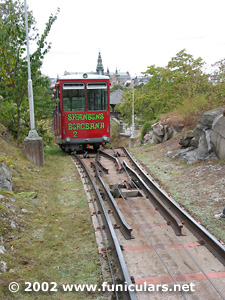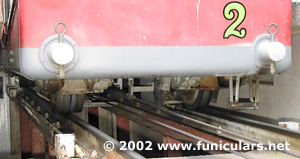|
s
How a funicular works

Switch with fixed switch blades. Funicular at Skansen.
|
The line - "Standard track"
The classic funicular consists of a long single track, with a passing track in the middle, where the two cars meet. The switches at the passing tracks have no moving parts as they would on a conventional railway; the blade of the switch is fixed.
Wheels
The wheels under the car are constructed as follows: the wheel on the outer rail at the passing track has flanges on both sides, so that it steers the car to the correct track. The inner wheel lacks flanges, and is somewhat larger, so it rolls easily over the crossing rails with their breaks for the cable to pass through.

On the right, wheel with double flanges; on the left, wheel without flanges. Funicular at Skansen.
|
This means that the cars always use the same track at the meet station, both on the way up and on the way down. Otherwise, the cables would end up hopelessly tangled in each other.
 previous page - contents - next page previous page - contents - next page 
© Text och photo: Bruse LF Persson
|